THE World Bank (WB) has raised its economic growth forecasts for the Philippines for this year and in 2025, driven by improved service exports and public investments.
But weak consumption and investment will keep the country’s growth below pre-pandemic levels, it said.
In its East Asia and Pacific Economic Update, the Washington-based multilateral lender now expects the Philippine economy to grow by 6% this year from 5.8%.
The Philippines could become the second-fastest growing economy in Southeast Asia, behind Vietnam (6.1%) and ahead of Cambodia (5.3%), Indonesia (5%), Malaysia (4.9%), Laos (4.1%), Timor-Leste (3%), Thailand (2.4%) and Myanmar (1%).
“Among the larger countries, only Indonesia is expected to grow in 2024 and 2025 above pre-pandemic levels, while growth in Malaysia, the Philippines, Thailand and Vietnam is expected to be below those levels,” the World Bank said.
For 2025, it forecasts Philippine economic output to expand by 6.1% from 5.9% in its April forecast.
The lender’s growth forecasts for the Philippines are at the low end of the government’s target of 6-7% for 2024 and below the 6.5-7.5% goal for next year.
The Philippine economy grew by 6.3% in the second quarter, faster than 5.8% in the previous quarter and 4.3% a year ago. In the first half, growth averaged 6%.
The World Bank said service exports and public investment have supported Philippine economic growth, but consumption and private investment remain weak.
From 2024 to 2026, the lender expects the Philippine economy to grow by an average of 6%, it said in a separate report.
This will be supported by remittances, jobs, slower inflation and external demand. However, weaker growth in China, global economic slowdown and weather disruptions are risks to the outlook.
It also projects the government’s budget deficit to fall to 4.6% of gross domestic product (GDP) by 2026 due to improved state spending. This is slightly below the 4.73% target for the year.
Better revenue collection will be supported by key tax measures, improved tax administration and higher dividends from state-owned corporations, the World Bank said.
The lender also raised this year’s growth forecast for the East Asia-Pacific region to 4.8% from 4.5% in April.
“Most East Asia-Pacific economies are expected to experience robust growth in 2024, supported by private consumption and a positive external environment,” according to the report. In 2025, the region is expected to grow by 4.4% from its previous forecast of 4.3%.
However, domestic demand is expected to moderate in the Philippines, Indonesia and Thailand, while private investment growth remains weak across the region.
“Investment growth has been declining across most countries in the region over the past two decades, with particularly sharp drops in China, Indonesia, Malaysia, and more recently, the Philippines.”
It also noted that the Philippines and Malaysia have kept a conservative fiscal stance due to their higher structural deficit this year.
GREATER POLICY SPACEThe World Bank expects inflation in the region to moderate within target amid stable input costs, tepid demand conditions and easing food inflation pressures. But inflation in Laos and Myanmar will likely stay elevated due to currency pressures.
“The combination of low domestic inflation and declining international interest rates is creating greater space for more supportive monetary policy in the East Asia-Pacific region,” it said, noting that the Philippines, China and Indonesia have adopted an “expansionary” monetary policy stance.
The Bangko Sentral ng Pilipinas (BSP) started its easing cycle in August, reducing the benchmark rate by 25 basis points (bps) to 6.25%.
BSP Governor Eli M. Remolona, Jr. last week signaled the possibility of delivering a 25-bp rate cut at each of the Monetary Board’s remaining meetings this year on Oct. 16 and Dec. 19.
“Cuts in US policy rates have created more space for monetary policy in the region, especially because domestic inflation has also significantly declined and is within target ranges in most countries,” World Bank East Asia and Pacific Chief Economist Aaditya Mattoo told a virtual news briefing on Tuesday.
“Countries in the East Asia and the Pacific Region continue to be an engine of growth for the world economy,” Manuela V. Ferro, vice-president of the World Bank for East Asia and the Pacific, said in a statement.
“However, growth is slowing. To sustain strong growth over the medium term, countries in East Asia and the Pacific must be proactive in modernizing and reforming their economies to navigate changing patterns of trade and technological change.”
Several risks could dampen East Asia-Pacific’s growth outlook, the World Bank said. These include a slowdown in the global economy, as well as the slower-than-expected decline in inflation in advanced economies, which could result in tighter global financial conditions.
Trade restrictions, which might be heightened after the US presidential elections, could also dampen regional growth, according to the lender.
Meanwhile, the World Bank expects the Philippines’ poverty rate to decline to 13.6% this year, before sliding to 11.3% in 2026, according to its latest Macro Poverty Outlook. Its previous forecasts were 12.2% and 9.3% for 2024 and 2026.
The country’s poverty incidence eased to 15.5% in 2023 from 18.1% in 2021, according to the local statistics agency.
“Despite the overall decline, there were provinces with rising poverty, most of which were affected by extreme weather events like El Niño and typhoons,” the World Bank said.
The Philippine government seeks to reduce the poverty incidence to 9% by the end of President Ferdinand R. Marcos, Jr.’s six-year term in 2028. — Beatriz Marie D. Cruz















